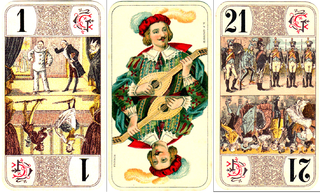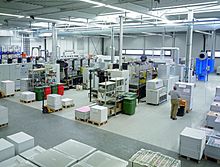
Altenburg is a city in Thuringia, Germany, located 40 kilometres south of Leipzig, 90 kilometres west of Dresden and 100 kilometres east of Erfurt. It is the capital of the Altenburger Land district and part of a polycentric old-industrial textile and metal production region between Gera, Zwickau and Chemnitz with more than 1 million inhabitants, while the city itself has a population of 33,000. Today, the city and its rural county is part of the Central German Metropolitan Region.

The standard 52-card deck of French-suited playing cards is the most common pack of playing cards used today. In English-speaking countries it is the only traditional pack used for playing cards; in many countries of the world, however, it is used alongside other traditional, often older, standard packs with different suit systems such as those with German-, Italian-, Spanish- or Swiss suits. The most common pattern of French-suited cards worldwide and the only one commonly available in English-speaking countries is the English pattern pack. The second most common is the Belgian-Genoese pattern, designed in France, but whose use spread to Spain, Italy, the Ottoman Empire, the Balkans and much of North Africa and the Middle East. In addition to those, there are other major international and regional patterns including standard 52-card packs, for example, in Italy that use Italian-suited cards. In other regions, such as Spain and Switzerland, the traditional standard pack comprises 36, 40 or 48 cards.
For over a century until 1996, F.X. Schmid was an important German manufacturer of playing cards, board games and puzzles. It was considered one of the major European manufacturers. In 1995, its turnover was 67 million DM and there were around 250 employees.

Wiener Spielkartenfabrik Ferd. Piatnik & Söhne, commonly referred to as Piatnik, is an Austrian playing card and board game manufacturing company based in Vienna.
Cartamundi Group is a company based in Turnhout, Belgium, that manufactures, produces, and sells board games, card games, collectible card games, packages, and playing cards through its manufacturing and sales subsidiaries. The name of the company in Latin means cards for the world. It is one of the world's largest playing card manufacturers.
Vass or VASS can refer to:

The Bourgeois Tarot deck is a mid-19th century pattern of tarot cards of German origin that is still used for playing card games today in western Europe and Canada. It is not designed for divinatory purposes. This deck is most commonly found in France, Belgian Wallonia, Swiss Romandy and Canadian Québec for playing French Tarot; in southwest Germany for playing Cego and Dreierles; and in Denmark for Danish Tarok.

Animal Tarot is a genre of tarot decks used for playing card games that were most commonly found in northern Europe, from Belgium to Russia, only one of which has survived: the Adler Cego pattern in south Germany. A theme of animals, real and/or fantastic, replaces the traditional trump scenes found in the Italian-suited tarot packs such as the Tarot of Besançon. The Sküs plays a musical instrument while the Pagat is represented by Hans Wurst, a carnival stock character who carries his sausage, drink, slap stick, or hat. They constitute the first generation of French-suited tarot patterns. Prior to their introduction, tarot card games had been confined to Italy, France, and Switzerland. During the 17th century, the game's popularity in these three countries declined and was forgotten in many regions. The rapid expansion of the game into the Holy Roman Empire and Scandinavia after the appearance of animal tarots may not be a coincidence. In the 19th century, most animal tarots were replaced with tarots that have genre scenes, veduta, opera, architecture, or ethnological motifs on the trumps such as the Industrie und Glück of Austria-Hungary.
Réunion, Reunion or Vereinigungsspiel is an historical German point-trick game for three players which, despite its French name, appears to have originated in the central Rhineland and lowland areas to the east. It is a 10-card game of the Ace-Ten family and uses a 32-card French-suited piquet pack or 32-card Skat pack. Players who cannot follow suit must trump. Otherwise the game can be described as a simplified version of Skat, but is also reminiscent of Euchre with its two permanent top trumps, the Right and Left Bowers.

Parts of Swiss German speaking Switzerland have their own deck of playing cards referred to as Swiss-suited playing cards or Swiss-suited cards. They are mostly used for Jass, the "national card game" of Switzerland. The deck is related to the various German playing cards. Within Switzerland, these decks are called German or Swiss German cards.

German-suited playing cards are a very common style of traditional playing card used in many parts of Central Europe characterised by 32- or 36-card packs with the suits of Acorns, Leaves, Hearts and Bells. The German suit system is one of the oldest, becoming standard around 1450 and, a few decades later, influencing the design of the now international French suit system of Clubs, Spades, Hearts and Diamonds. Today German-suited playing cards are common in south and east Germany, Austria, German-speaking Switzerland, Liechtenstein, north Italy, Hungary, Czech Republic, Slovakia, Slovenia, Croatia, Bosnia, northern Serbia, southern Poland and central and western Romania.

French-suited playing cards or French-suited cards are cards that use the French suits of trèfles, carreaux, cœurs, and piques. Each suit contains three or four face/court cards. In a standard 52-card deck these are the valet, the dame, and the roi (king). In addition, in Tarot packs, there is a cavalier (cavalier) ranking between the queen and the jack. Aside from these aspects, decks can include a wide variety of regional and national patterns, which often have different deck sizes. In comparison to Spanish, Italian, German, and Swiss playing cards, French cards are the most widespread due to the geopolitical, commercial, and cultural influence of France, the United Kingdom, and the United States in the 19th and 20th centuries. Other reasons for their popularity were the simplicity of the suit insignia, which simplifies mass production, and the popularity of whist and contract bridge. The English pattern of French-suited cards is so widespread that it is also known as the International or Anglo-American pattern.

Binokel is a card game for two to eight players that originated in Switzerland as Binocle, but spread to the German state of Württemberg, where it is typically played with a Württemberg pattern pack. It is still popular in Württemberg, where it is usually played in groups of three or four as a family game rather than in the pubs. In three-hand games, each player competes for himself, while in four-hand games, known as Cross Binokel (Kreuzbinokel), two teams are formed with partners sitting opposite one another. The game was introduced to America by German immigrants in the first half of the 20th century, where it developed into the similar game of pinochle. Binocle was still played in Switzerland in 1994. In south Germany, the game is sometimes called by its Swabian name, Benoggl.

The history of the game of Skat or Scat began in the early 19th century in Thuringia. The game spread rapidly within German-speaking Europe and also in the US and is now one of the most popular card games in Germany as well as being considered Germany's national card game.

Enflé, Rolling Stone, Farbenjagd or Schweller is an early nineteenth-century French trick-taking card game for three or more players that has been described as a "simple but maddening game" having "a lot of similarity to Rams and no less entertaining." It has also been called "one of the best children's games."

Nürnberger-Spielkarten-Verlag (NSV) is a German playing card manufacturer and board game publisher based in Nuremberg. It was founded in 1989 after outsourcing from the publishing house of F.X. Schmid and builds on the "Heinrich Schwarz Playing Card Factory, Nuremberg" founded in 1948. The company produces playing cards and dice games s and, especially in recent years, increasingly proprietary games from various game authors.
Bielefelder Spielkarten was a mid-20th century, German manufacturer of playing cards based in Bielefeld, Germany.

The German Playing Card Museum in Leinfelden-Echterdingen is a branch of the Württemberg State Museum and houses one of the largest public playing cards collections in Europe. It is open to all ludologists and those with private interests. Playing cards are systematically collected, archived and researched. The collection includes around 15,000 decks with over 500,000 individual cards, a games library with an archive, a graphics collection, as well as arts and crafts objects, card presses, glasses, gaming tables, etc. One rarity is its Asian-Indian collection. It is considered the most comprehensive museum of its type in the world. The museum is a member of the International Playing Card Society.
C.L. Wüst was a German playing card manufacturer that was founded by Conrad Ludwig Wüst in 1819 and was active until 1927.
Dondorf or B. Dondorf was a luxury playing card company, founded in Frankfurt in 1833, that produced playing cards for 100 years.



















